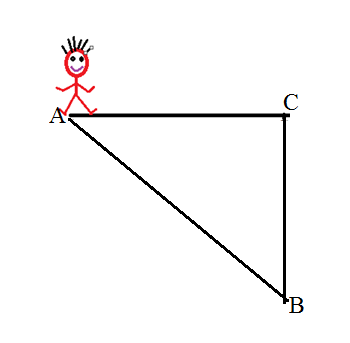
Concept explainers
To Find: Magnitude of the displacement is less than or more than the distance travelled.
Answer to Problem 1P
Magnitude of the displacement is always less than or equals to the distance travelled.
Explanation of Solution
Introduction:
Distance can be defined as the total path length travelled by a body. Its S.I. unit is
Where,
Displacement can be defined as the path difference between the initial and final position of the body. It is the minimum distance between two points.
Its S.I. unit is
Here are some examples,

Consider a body is travelling along a straight line from A to B and then B to C.
Total distance travelled by the body
Displacement of the body
Consider a body is moving in a circular path of radius
Since,
Therefore, distance travelled > displacement

Total distance traveled by the body = circumference of the circle
Displacement of the body = final position − initial position.
Here body come to its initial position after revolution
Therefore,
final position = initial position
hence,
Displacement of the body
Again, distance > displacement

Consider a body travelling in a straight line from A to B
Distance travelled = AB
Displacement = AB
Here, Displacement = Distance travelled
Conclusion:
Displacement of a body can never be greater than the distance travelled by the body. It is either equal to the distance travelled by the body or less than it.
Want to see more full solutions like this?
Chapter 3 Solutions
Physics for Scientists and Engineers
- Suppose two vectors have unequal magnitudes. Can their sum be 0→?Explain.arrow_forwardIf the velocity of a particle is zero, can the particle's acceleration be zero? Give an example. If the velocity of a particle is not zero, can the particle's acceleration be zero? Give an example.arrow_forward2) The position of a particle traveling along a curved path is s = (3t3 - 4t² + 4) m, where t is in seconds. When t = 2 s, the particle is at a position on the path where the radius of curvature is 25 m. Determine the magnitude of the particle's acceleration at this instant.arrow_forward
- 4) Find the time or times in the given time interval when velocity and acceleration vectors are orthogonal; r(t) = i + (5 cos t)j + (3 sin t)k, 0arrow_forwardA cross-country skier skis 1.0 km north and then 2.0 km east. How far and in what direction is she from the starting point? What are the magnitude and direction of her resultant displacement? (Complete solution)arrow_forwardRaindrops hitting the side windows of a car in motion often leave diagonal streaks even if there is no wind. Why? Is the explanation the same or different for diagonal streaks on windshield? Explain in 10 sentencesarrow_forwardQuestion (äbäi 4) If vector B is added to vector Á, the result is 6i + j. If B is subtracted from ä, the result is -4i+ 7i. What is the magnitude of A 1.2 2.3 4.1 6.2 7.1arrow_forwardWhich of the following objects is undergoing uniform circular motion> a. An object speeding up at a constant rate while following a circular path. b. An object whose velocity is changing at a constant rate in a given direction. c. An object undergoing acceleration with a constant magnitude directed towards the centre of its circular path. d. An object that is traveling at constant speed around a circular path.arrow_forward7) A particle moves along a plane circular path of radius r equal to 1 ft. The position OA is given as a function of time as 0 = 6 sin(5t) rad, where t is in seconds. What are the rectangular compo- nents of velocity and acceleration for the particle at t = = sec? 8arrow_forwardUnder what circumstances does distance traveled equal magnitude of displacement? What is the only case in which magnitude of displacement and displacement are exactly the same?arrow_forwardIf two vectors are equal, what can you say about their components? What can you say about their magnitudes? What can you say about their directions?arrow_forwardA particle initially located at the origin has an acceleration of a=3.00jm/s2 and an initial velocity of vi=5.00im/s. Find (a) the vector position of the particle at any time t, (b) the velocity of the particle at any time t, (c) the coordinates of the particle at t = 2.00 s, and (d) the speed of the particle at t = 2.00 s.arrow_forwardarrow_back_iosSEE MORE QUESTIONSarrow_forward_ios
 Principles of Physics: A Calculus-Based TextPhysicsISBN:9781133104261Author:Raymond A. Serway, John W. JewettPublisher:Cengage Learning
Principles of Physics: A Calculus-Based TextPhysicsISBN:9781133104261Author:Raymond A. Serway, John W. JewettPublisher:Cengage Learning University Physics Volume 1PhysicsISBN:9781938168277Author:William Moebs, Samuel J. Ling, Jeff SannyPublisher:OpenStax - Rice University
University Physics Volume 1PhysicsISBN:9781938168277Author:William Moebs, Samuel J. Ling, Jeff SannyPublisher:OpenStax - Rice University College PhysicsPhysicsISBN:9781285737027Author:Raymond A. Serway, Chris VuillePublisher:Cengage Learning
College PhysicsPhysicsISBN:9781285737027Author:Raymond A. Serway, Chris VuillePublisher:Cengage Learning Glencoe Physics: Principles and Problems, Student...PhysicsISBN:9780078807213Author:Paul W. ZitzewitzPublisher:Glencoe/McGraw-Hill
Glencoe Physics: Principles and Problems, Student...PhysicsISBN:9780078807213Author:Paul W. ZitzewitzPublisher:Glencoe/McGraw-Hill College PhysicsPhysicsISBN:9781938168000Author:Paul Peter Urone, Roger HinrichsPublisher:OpenStax College
College PhysicsPhysicsISBN:9781938168000Author:Paul Peter Urone, Roger HinrichsPublisher:OpenStax College Physics for Scientists and EngineersPhysicsISBN:9781337553278Author:Raymond A. Serway, John W. JewettPublisher:Cengage Learning
Physics for Scientists and EngineersPhysicsISBN:9781337553278Author:Raymond A. Serway, John W. JewettPublisher:Cengage Learning





